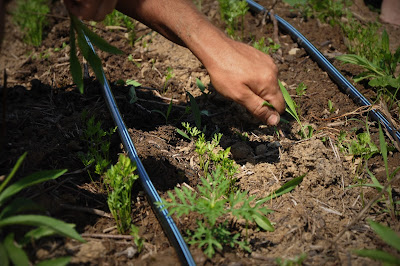 |
| Hand-weeding carrots, summer 2015 |
But almost as soon as we do, we'll have to start contending with the onslaught of weeds that are just waiting for the warmth to grow.
In fact by the time the end of July rolls around, we'll wonder if the weeds will ever go away. We'll curse the cruel mechanism of our humanity that causes us to dream about said weeds when we're supposed to be recuperating briefly in the dark of the night.
Weeding.
There. We just wanted weeding to have its own, fully dedicated paragraph. Weeds really do collectively rule us. They are simultaneously our biggest foe and one of our greatest inspirations. Yes, you heard the latter part right.
See, though we dread them, weeds have a purpose that people don't acknowledge enough: they maintain life in the soil. A weed is any plant that you don't want growing in a particular space. They could be invasive, imported, noxious plants; volunteers from plants you intentionally planted in previous years; or even natives that once ruled the landscape before humans decided to shape the land to their liking. While no one wants those noxious invasives around, land that will not grow weeds is effectively dead land that serves no purpose to anyone or anything.
Because, beneath the surface, plants send out roots and lay the groundwork for all kinds of relationships that shape our planet. Bacteria set up networks and develop symbiotically with plants. Worms and other insects help digest decaying matter and turn it into nutrients. Together, they all grow to create a community that even the most advanced soil scientists still barely understand. When you factor in photosynthesis and plants sacrificing themselves as a food source for animals, you begin to realize just how far and wide the ripples travel.
So, while we complain about these unwanted plants, when we look at our land that grows all kinds of diverse greenery of its own volition, in the back of our minds we know these are positive signs. During the past two years we've watched what was almost exclusively a field of compacted clay dominated by goldenrod turn into a multispecies forest of plants, some of which are edible. As we've added organic matter and turned the soil, long-buried seeds have sprouted to re-establish a community that was once sprayed out of existence. Diversity is almost always a good thing.
While part of our job is to control what grows on our land, we can also recognize that nature knows how to do it right. Diversity is the name of her game, and we strive to mimic her methods as much as we can. Which is why we grow hundreds of varieties of plants for our CSA members. Check out our 2016 crop list and snag a share while you still can. They are a-movin', y'all!